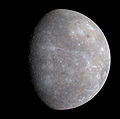ملف:Mercury in color - Prockter07 centered.jpg

حجم هذه المعاينة: 605 × 600 بكسل. الأبعاد الأخرى: 242 × 240 بكسل | 484 × 480 بكسل | 775 × 768 بكسل | 1٬033 × 1٬024 بكسل | 1٬991 × 1٬974 بكسل.
الملف الأصلي (1٬991 × 1٬974 بكسل حجم الملف: 1٫72 ميجابايت، نوع MIME: image/jpeg)
تاريخ الملف
اضغط على زمن/تاريخ لرؤية الملف كما بدا في هذا الزمن.
| زمن/تاريخ | صورة مصغرة | الأبعاد | مستخدم | تعليق | |
|---|---|---|---|---|---|
| حالي | 12:49، 4 يونيو 2008 |  | 1٬991 × 1٬974 (1٫72 ميجابايت) | Papa Lima Whiskey | {{Information |Description=Full color image of from first MESSENGER flyby |Source=NASA/JPL [http://messenger.jhuapl.edu/gallery/sciencePhotos/image.php?page=1&gallery_id=2&image_id=143] |Date=2008-01-30 |Author=NASA/[[w:Applied Physics Laborato |
استخدام الملف
ال29 صفحة التالية تستخدم هذا الملف:
- 1981 ميداس
- استكشاف عطارد
- اكتشاف واستكشاف النظام الشمسي
- برنامج مارينر
- بيبيكولومبو
- جيولوجيا عطارد
- حفرة فلايانو
- حقل عطارد المغناطيسي
- حوض كالوريس
- عبور الشمس
- عبور عطارد
- عبور عطارد من الزهرة
- عطارد
- عطارد في الخيال
- غلاف عطارد الجوي
- قائمة أجرام المجموعة الشمسية مرتبة حسب الحجم
- قائمة أنواع الكواكب
- قائمة الأجرام المستديرة بالجاذبية في المجموعة الشمسية
- كوكب
- مارينر 10
- مستخدم:ASammour/صور مختارة
- مستخدم:محمد 19951/ملعب13
- ويكيبيديا:هل تعلم/قائمة/68
- ويكيبيديا:هل تعلم/قائمة شاملة
- قالب:المجموعة الشمسية
- قالب:بذرة كوكب عطارد
- قالب:عطارد
- بوابة:المجموعة الشمسية
- بوابة:المجموعة الشمسية/قوالب
الاستخدام العالمي للملف
الويكيات الأخرى التالية تستخدم هذا الملف:
- الاستخدام في ab.wikipedia.org
- الاستخدام في af.wikipedia.org
- الاستخدام في ang.wikipedia.org
- الاستخدام في anp.wikipedia.org
- الاستخدام في an.wikipedia.org
- الاستخدام في ar.wiktionary.org
- الاستخدام في arz.wikipedia.org
- الاستخدام في ast.wikipedia.org
- الاستخدام في as.wikipedia.org
- الاستخدام في avk.wikipedia.org
- الاستخدام في awa.wikipedia.org
- الاستخدام في bat-smg.wikipedia.org
- الاستخدام في ba.wikipedia.org
- الاستخدام في bcl.wikipedia.org
- الاستخدام في bcl.wiktionary.org
- الاستخدام في be.wikipedia.org
- Меркурый
- Партал:Астраномія
- Партал:Астраномія/Навігацыя
- Каланізацыя Меркурыя
- Праходжанне Меркурыя па дыску Сонца
- Шаблон:Меркурый
- Спіс аб’ектаў Сонечнай сістэмы па памерах
- Спіс уступаў на Меркурыі
- Спадарожнік Меркурыя
- BepiColombo
- Зрушэнне перыгелія Меркурыя
- Шаблон:Добрыя артыкулы
- Толкін (кратар)
- Шаблон:Выбраны змест/Меркурый
- الاستخدام في bg.wikipedia.org
- الاستخدام في bh.wikipedia.org
- الاستخدام في bjn.wikipedia.org
- الاستخدام في blk.wikipedia.org
- الاستخدام في bn.wikipedia.org
اعرض المزيد من الاستخدام العام لهذا الملف.




